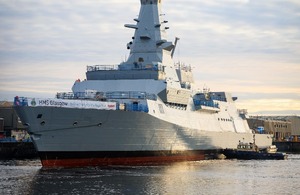HMS Glasgow naming ceremony marks milestone for UK security and economy
The people and city of Glasgow have been honoured today (22 May) as the Royal Navy's most advanced anti-submarine warfare warship is officially named HMS Glasgow.

HMS Glasgow, Type 26 anti-submarine warfare warship
The naming ceremony at BAE Systems’ shipyard in Glasgow was attended by the Prince and Princess of Wales. Smashing a bottle of whisky against the hull for good luck, Her Royal Highness formally named HMS Glasgow and declared the time-honoured words:
I name this ship Glasgow. May God bless her and all who serve in her.
The Type 26 frigate is the first of eight to enter service and will provide critical protection for the UK’s nuclear deterrent and aircraft carriers.
The Type 26 programme represents a £7.9 billion investment in British shipbuilding. It directly supports 2,000 jobs in Scotland, including apprenticeships, at BAE Systems’ Govan and Scotstoun shipyards in Glasgow, with a further 4,000 roles sustained across the wider UK supply chain until 2035.
This long-term commitment shows how defence is an engine for growth, supporting the Government’s Plan for Change to grow the economy, particularly in Scotland.
Defence Secretary, John Healey MP said:
HMS Glasgow represents the best of British engineering and shipbuilding. The warship will serve as a formidable defender of our national security and a powerful asset for NATO in an increasingly dangerous world.
The shipbuilding programme supports thousands of highly-skilled jobs in Scotland and across the UK, supporting the government’s Plan for Change and reinforcing the role of defence as a powerful engine for growth.
Equipped with sophisticated weapons systems, advanced sensors and state-of-the-art communications technology, HMS Glasgow will ensure our Royal Navy makes Britain secure at home and strong abroad.
Delivering on the government’s Plan for Change, the programme directly supports 1,700 skilled jobs at BAE Systems’ Govan and Scotstoun shipyards in Glasgow, with a further 2,300 roles sustained across the wider UK maritime supply chain until 2035. More than 120 UK suppliers have been contracted for the programme, with BAE Systems committing to invest £1.2 billion in UK manufacturing through sub-contracts.
The warship’s flexible design allows for future upgrades throughout its service life, ensuring it remains at the forefront of naval technology for decades to come. The Type-26 design has also achieved international success, having been selected by both Australia and Canada for their future frigate programmes.
This has transformed the programme into a 29-ship global endeavour across three independent national programmes, creating significant long-term opportunities for the UK supply chain and enhancing naval interoperability with key allies. This includes up to six Australian Hunter Class Frigates and up to fifteen Canadian River Class Destroyers alongside the UK’s eight City class ships.
Acting 1SL and Chief of Naval Staff, Vice Admiral Sir Martin Connell added:
HMS Glasgow represents a step-change in anti-submarine warfare capability for the Royal Navy. As threats beneath the waves become more sophisticated, these warships will ensure we maintain our underwater advantage and protect our most critical strategic assets for decades to come.
With HMS Glasgow expected to be operational by 2028, construction of all eight City class frigates is scheduled to be completed by the mid-2030s. They will be based at HMNB Devonport in Plymouth, forming the backbone of the Royal Navy’s surface fleet.